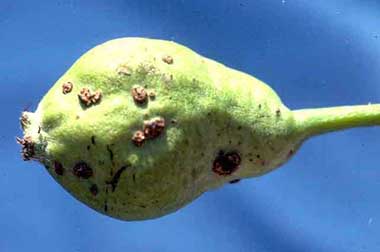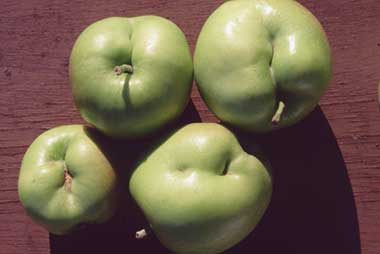Lygus Bugs
General Description
Lygus bugs are among a group of piercing and sucking insects along with stink bugs and boxelder bugs that cause severe damage to fruit under high populations. Feeding on flower buds and young fruit results in unsightly dimpling, deformity and scarring known as "cat-facing".
Hosts
Lygus bugs feed on a wide variety of plants, including tree fruits, alfalfa, canola and broadleaf weeds.
Damage
Feeding damage includes abortion of blossoms and drop or deformity ("cat-facing") of developing fruit. Most injury is done prebloom or early petal fall. Prebloom feeding on pear buds causes sap to ooze from the feeding sites punctures, and later as brownish pustules (some crescent shaped) on the fruit (Fig. 1).
 |
| Figure 1. Early season lygus bug feeding injury to pear. (BCMA) |
Apples can show severe deformation as a result of lygus bug feeding (Fig. 2). Some damage can occur later, especially if forced from nearby harvested alfalfa, canola crops or other alternative hosts.
 |
| Figure 2. Lygus bug feeding injury to apple. (BCMA) |
Identification
Nymphs - pale yellow or reen; resemble adults but has no wings and smaller (Fig. 3).
.jpg) |
| Figure 3. Lygus bug nymph. (R. E. Berry. Department of Entomology, Oregon State University, Corvallis, OR.) |
Adults - about 6 mm long, pale green to brown with yellow, black and reddish markings (Fig. 4). Fly readily when disturbed.
.jpg) |
| Figure 4. Adult lygus bug. (R. E. Berry. Department of Entomology, Oregon State University, Corvallis, OR.) |
Life History
Lygus bugs overwinter as adults in plant debris on the orchard floor or in nearby alfalfa crops, headlands or other uncultivated areas. A favourite overwintering site is between the dead leaves of mullein. Adults are active in the spring when they fly to fruit trees to feed on developing flower buds. There are 3-4 generations per year
Monitoring
Beginning in April, use a sweep net to sample ground cover in and around orchards, and limb taps or visual examination of buds for feeding adults or their damage.
Management
Biological Control
Big-eyed, damsel, and assassin bugs, as well as crab spiders will feed on lygus bug nymphs on cover crops and host plants in the absence of harmful pesticides.
Cultural Control
Removing alternate hosts, or cover crops with predominantly grasses can reduce populations in orchards. Destroy broadleaf weed host such as mullein outside the orchard to reduce lygus bug migration into the orchard in the spring and summer.
Chemical Control
Lygus bugs can cause damage when forced to leave adjacent harvested alfalfa fields. At present there is no control product to protect trees from invading lygus bugs. An alternative is to spray the alfalfa crop 28 days before harvest with Cygon or Lagon to control lygus bugs.
